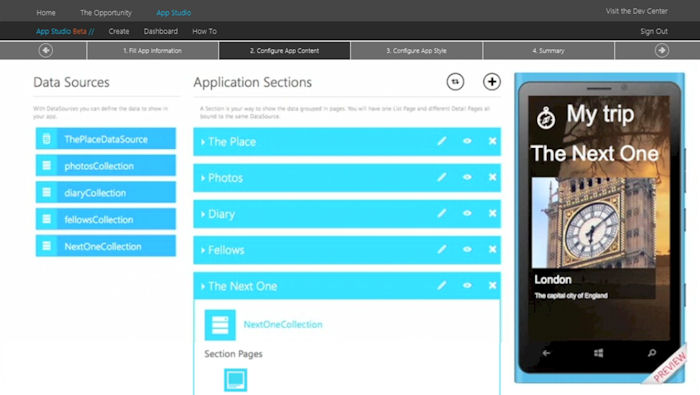
From the official blog post:
Look around in App Studio and you’ll see that the menu bar now makes it easier to navigate. We enhanced the navigation buttons and made it much easier to edit collections after an app is created. We added dozens of new graphics elements: icons, backgrounds, and stock images you can use to enhance and sharpen the visual identity of your app.
In response to your feedback, in this newest version, we’ve integrated with SkyDrive, making it easy to access your pictures. (By the way, did you know that if you make your collections dynamic we keep all of your data stored in the cloud, and you can edit them without creating a new version of your app?)
We’ve also made a ton of progress enhancing the Visual Studio project template and the code that it generates. Our goal is clean and lean code that’s easier to read and which speeds up the app creation process. I invite you to review the source code and Visual Studio project template to experience firsthand some of our App Studio updates: improved naming conventions for consistency across your project, simplified projects and app manifests, and pinch to zoom.
While you're not going to make a Halo using the web based tool, it does open up information based apps to those without detailed programming knowledge. Keeping as much of the process in the browser is smart thinking.
This doesn't mean there will be a rush of single page RSS apps into the Windows Phone store. While you'll be able to sideload the app to your own phone, publishing to the store will come later. Developers looking to use the App Builder as a rapid prototyping tool can export their prototype app to Visual Studio to continue working on it, and publishing it from there.

The tool is useful, what comes out is up to you, as Rafe pointed out here on AAWP at the launch:
Windows Phone App Studio is a powerful tool, going beyond the capabilities of most web-based app builders. That's partly because it is tuned specifically to Windows Phone, but the flexibility of the data sources content system (especially collections) is a real highlight too. Apps created using the tool have the potential to be genuinely useful, although equally there's potential to create poor apps.
Put in a few hours work and it should be possible to create a decent app, although we would recommend thinking about the content you want to include ahead of time. Apps created by the tool can be shared with the world, but in many ways the possibility of individuals creating apps for their own usage (e.g. family photo collection) is more intriguing.
You can get started by heading over to apps.windowsstore.com.
